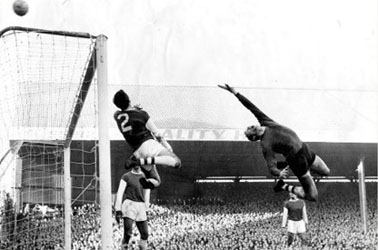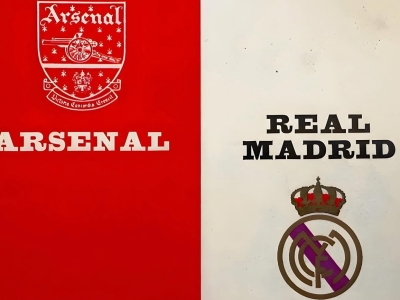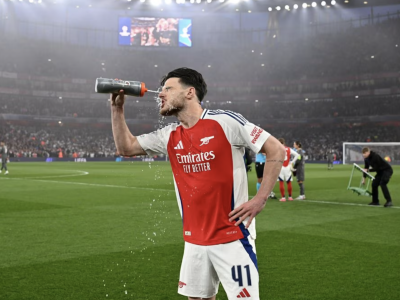Arsenal’s earliest association with the land of Wales came one hundred and twenty years ago, when Arsenal signed Cesar Llewellyn Jenkyns from Small Heath (later renamed Birmingham City) in April 1895. His exit from Small Heath was hastened after he attempted to assault two spectators after being sent off at Derby County. Eleven months on, Jenkyns was selected for Wales for their Home Nations international against Scotland and in the process became Woolwich Arsenal’s first ever international player ten years after their formation. Despite being a star player however, Jenkyns blazed a trail later followed by Frank Stapleton and Robin Van Persie in ditching Arsenal for Man Utd (then named Newton Heath F.C.).
Arsenal’s first fixture against Welsh opposition came in January 1915, after being drawn away to Merthyr Town in the First Round of the FA Cup (the tie switched to Highbury by mutual agreement and became the ground’s first ever Cup tie). The match took place while the First World War proceeded, Arsenal winning 3-0 with a hat-trick from Henry King, who a couple of months earlier scored Highbury’s first ever hat-trick against Grimsby Town and in his only season at Arsenal scored twenty six goals in just thirty seven games. This here is an article on Merthyr’s visit to Highbury for ‘Dial M for Merthyr’ - the fanzine for the successor club Merthyr Tydfil FC.
Merthyr were in the Southern League at the time of their visit to Highbury, but would join the Football League in its Post-WW1 expansion in 1920 however were to last just ten years when they failed re-election in 1930 and were replaced by Thames Association FC – a club who were founded purely to fill the West Ham Speedway Stadium but folded two years later. Merthyr Town were wound up in 1934 due to debts which amounted to £200,000 in today’s money, but would be reformed as Merthyr Tydfil in 1945, who would continue until liquidated in 2010 and reformed again reprising the moniker of Merthyr Town. Arsenal’s next fixture against Welsh opposition would come on Boxing Day of 1921 against Cardiff City at Highbury.
The Bluebirds were also admitted to the Football League in 1920, going straight into Division Two as they were the best team in Wales and were promoted at the first attempt. Their first visit to Highbury ended in a 0-0 draw, twenty four hours later Arsenal visited Ninian Park in Cardiff but were defeated 3-4. Cardiff’s best season in the top flight came in 1923/24, going into the final game of the season one point clear of Herbert Chapman’s Huddersfield Town, however would concede a late penalty meaning that the title went to Huddersfield on goal average. That season Cardiff would defeat Arsenal three weeks in a row - inflicting a 1-2 defeat on the Gunners in the League at Highbury on 19th January, a 0-4 defeat away at Ninian Park on 26th January and eliminating Arsenal from the FA Cup with a 0-1 defeat on 2nd February.
Two seasons later Arsenal would be eliminated from the FA Cup by Welsh opposition, this time by Cardiff’s South Wales neighbours Swansea Town (they were not to be called City until their home town were granted City status in 1969). Despite languishing in the Second tier of English football, Swansea reached the FA Cup Semi Finals in 1925/26 inflicting a 1-2 defeat on Herbert Chapman’s Arsenal at the Vetch Field in the Quarter Final just fourteen years after the Swans were founded. The following year Arsenal would reach the final for the first time, however would be upended by Welsh opposition again, losing 0-1 to Cardiff at Wembley through an infamous error by their Welsh goalkeeper Dan Lewis. It would be the first and only time the FA Cup would be won by a non-English based side, however would be the peak of this Cardiff side’s achievements and the club would go in a drastically different direction to Arsenal.
Regular fixtures against Cardiff would continue in the League until the end of the 1928/29 season, when the Bluebirds would be relegated to the Second tier by finishing rock bottom of the table (although actually conceded the fewest goals in the top flight that season!). By the end of 1930/31 season when Arsenal won their first title Cardiff were relegated to the Third Division South. Arsenal would not face Welsh opposition again until after the Second World War, however Arsenal’s great side of the 1930s would include Welshmen such as left back Bob John, right half Charlie Jones and a British record transfer fee paid out to Wolves for inside forward Bryn Jones in 1938.
The next meeting with Welsh opposition would come in the fourth round of Arsenal’s victorious 1950 FA Cup campaign, in which Arsenal would defeat Swansea 2-1 at Highbury. Among the Arsenal goals that day would be Welshman Walley Barnes. Other Welsh stars for Arsenal in the early post-war period would include Derek Tapscott, Ray Daniel, Jack Kelsey, Dave Bowden and Mel Charles, (the latter being the brother of Leeds Utd. and Juventus star John Charles) whose signing for Arsenal from Swansea in 1959 is covered here in this ITN footage. Cardiff City would return to the top tier in 1952/53 and even inflict a 0-1 defeat on Arsenal at Highbury. In 1954/55 Arsenal would face Cardiff again in the FA Cup for the first time since the 1927 Final. This time Arsenal would triumph with a 1-0 victory with a goal from Tommy Lawton.
In 1956/57 Arsenal would also visit Newport County in the fourth round of the FA Cup away, leaving with a 2-0 victory with goals from David Herd and Derek Tapscott. At the end of that season Cardiff would be relegated to the second tier, but return to the top flight in 1960/61 and do the double over Arsenal, inflicting a 0-1 defeat on Arsenal in late September at Ninian Park, as well as 2-3 defeat at Highbury in February despite two goals from David Herd. The following season Cardiff held Arsenal to a 1-1 draw at Highbury in March 1962, Arsenal’s goal scored by Geoff Strong. Cardiff however would be relegated from the top tier that season meaning that it would be another two decades before Arsenal would play a league fixture against Welsh opposition.
In the meantime Arsenal would meet Swansea at the Vetch Field in February 1968, which drew the Swans record attendance of 32,786. In comparison, a month earlier a mere tenth of that figure saw Swansea play at home against Lincoln City. Arsenal won the game 1-0 with a goal from future Wales manager Bobby Gould. Playing for Swansea that day was Ivor Allchurch, who was the star of Wales’s last qualification for a major tournament – the 1958 World Cup in Sweden – as well as turning out when the sides last played in 1950, with Arsenal manager Tom Whittaker remarking that Allchurch was the ‘player of the century’. A statue of Allchurch stands at Swansea’s new ground, the Liberty Stadium. The Swansea side that played Arsenal included Roy Evans (not to be confused with the former Liverpool manager of the same name) and Brian Purcell, who just eleven months later would both be tragically killed in a road traffic accident while on route to an away fixture.
The following season Arsenal would be drawn away to Welsh opposition in the FA Cup again, this time Cardiff City. Cardiff held Arsenal to a 0-0 draw, before Arsenal triumphed 2-0 back at Highbury with goals from George Armstrong and Bobby Gould. Arsenal would not be drawn away to Welsh opposition again until 1978, when Arsenal faced Wrexham away on route to Wembley in the Quarter Finals. The Welsh side were top of the third tier at the time, which they went on to win that season. Wrexham had previously eliminated top flight Newcastle in the fourth round, holding the Magpies to a 2-2 draw at St. James’s Park and a thumping 4-1 win in the replay at the Racecourse Ground. In the fifth round Wrexham eliminated fellow giant killers Blyth Spartans after a replay.
Lining up against Arsenal that day had been Centre Half John Roberts, who seven years earlier had been a member of Arsenal’s double squad. Wrexham were managed by future Chelsea manager John Neal, their squad that year also included former Everton goalkeeper Dai Davies, winger Mickey Thomas who faced Arsenal in the FA Cup Final fourteen months later for Manchester United, goal scorer Dixie McNeill and future Chelsea goalkeeper and Arsenal reserve coach Eddie Niedzwiecki. Wrexham’s Cup exploits that year led to Wrexham-born guitarist of 70s hit makers The Sweet to wear a Wrexham rosette on Top of the Pops for their performance of their last hit ‘Love is Like Oxygen’. In the event Arsenal left the Racecourse Ground with a 3-2 victory with goals from Malcolm MacDonald, Alan Sunderland and Willie Young.
That same month, while languishing in the fourth division Swansea City had appointed former Liverpool striker John Toshack as manager at the age of just twenty eight and so began the rise of a new powerhouse in Welsh football with the Swans rising up four divisions in just five seasons, no mean feat considering that they were forced to apply for re-election to the Football League at the end of the 1974/75 season. In the meantime, Arsenal would face Cardiff City in the third round of the FA Cup in 1980, the Bluebirds holding Arsenal to a 0-0 draw at Ninian Park while Arsenal triumphed 2-1 in the replay at Highbury three days later with both goals scored by Alan Sunderland. The following season Arsenal would face Swansea City in a two-legged second round of the League Cup, the Swans holding Arsenal to a 1-1 draw at the Vetch Field with a goal for Frank Stapleton. In the second leg at Highbury a week later Arsenal would triumph 3-1 with a penalty from John Hollins, and goals from Alan Sunderland and Steve Walford.
That season however, Swansea City would secure promotion to the top flight for the first time, with performances such as a 3-3 draw with neighbours Cardiff and victories such as a 3-0 win against Chelsea and a victory over Preston North End which secured promotion. As will be seen tomorrow, very briefly South Wales’s new footballing powerhouse would set the old First Division alight, along with some notable early eighties battles with an Arsenal side in an early to mid-1980s malaise.
*Follow me on Twitter@robert_exley








